Services on Demand
Journal
Article
Indicators
-
 Cited by SciELO
Cited by SciELO -
 Access statistics
Access statistics
Related links
-
 Cited by Google
Cited by Google -
 Similars in
SciELO
Similars in
SciELO -
 Similars in Google
Similars in Google
Share
Revista de la Academia Colombiana de Ciencias Exactas, Físicas y Naturales
Print version ISSN 0370-3908
Rev. acad. colomb. cienc. exact. fis. nat. vol.39 no.150 Bogotá Jan./Mar. 2015
Departamento de Matemáticas, Universidad del Valle, Cali, Colombia. *Correspondencia: J. R. Quintero: jose.quintero@correounivalle.edu.co.
Recibido marzo 2014; aceptado diciembre 2014.
Abstract
In this paper we establish the existence of periodic travelling waves for a 2D Boussinesq type system in threedimensional water-wave dynamics in the weakly nonlinear long-wave regime. For wave speed |c| > 1 and large surface tension, we are able to characterize these solutions through spatial dynamics by reducing a linearly ill-posed mixed type initial value problem to a center manifold of finite dimension and infinite codimension. We will see that this center manifold contains all globally defined small-amplitude solutions of the travelling wave equation for the Boussinesq system that are periodic in the direction of propagation.
Key words: periodic travelling waves, center manifold approach, stability
Resumen
En este artículo establecemos un resultado de existencia de ondas periódicas para un sistema 2D del tipo Boussinesq que describe la evolución de ondas de agua de gran elongación y pequeña ampitud que son débilmente lineales. Para velocidad de onda |c| > 1 y tensión superficial suficientemente grande, estas soluciones son caracterizadas a través de dinámica espacial al reducir el problema de valor inicial (mal puesto a nivel lineal) a una variedad central de dimensión finita y codimensión infinita. Se mostrará que dicha variedad central contiene todas las soluciones de onda viajera de pequenã amplitud para el sistema tipo Boussinesq que son periódicas en la dirección de propagación de la onda.
Palabras clave: ondas viajeras periódicas, método de variedad central, estabilidad.
1. Introduction
This paper presents an existence result of nonlinear travelling water waves which are periodic in their direction of propagation and have a pulse structure in the unbounded transverse spatial direction. As done for a wide range of applications, we use spatial dynamics and center manifold reduction to obtain such a result in a model related with the water-wave problem. Here the expression "spatial dynamics" means to perform a method in which a system of partial differential equations governing a physical problem is formulated as a evolutionary equation (in general ill-posed)

in which an unbounded spatial coordinate plays the role of the timelike variable z (see Kirchgässner (1982)). In this paper the method is applied to studying the existence of non trivial periodic travelling wave for the Boussinesq type system related with the water wave problem

where √m = h0/L is the ratio of undisturbed fluid depth to typical wave length (long-wave parameter or dispersion coefficient), and ∈ is the ratio of typical wave amplitude to fluid depth (amplitude parameter or nonlinearity coefficient), s-1 is the Bond number (associated with the surface tension), F is the rescale nondimensional velocity potential on the bottom z = 0, and h is the rescaled free surface elevation. We consider waves which are periodic in a moving frame of reference, so that they are periodic in the variable x - ct, where t denotes the temporal variable. For this physical problem, we have a bounded spacelike coordinates (the vertical direction), which is bounded because the fluid has finite depth, and the coordinate x - ct which is considered bounded because we are looking for periodic wave in this variable. So, since there is not any restriction upon the behavior of the waves in the spatial direction y transverse to their direction of propagation, we are allowed to use it as timelike variable. We apply spatial dynamics to the problem by formulating this as an evolutionary system of the form (1.1) with z = y in an infinite-dimensional phase space consisting of periodic functions of x-ct (see Grover & Schneider (2001), Sandstede & Scheel(1999), Sandstede & Scheel(2004), and Haragus-Courcelle & Schneider (1999) for applications to respectively nonlinear wave equations, reaction-diffusion equations, and Taylor-Couette problems, and Quintero & Pego(2002) for periodic nonlinear travelling for the Benney-Luke model).
In the case of wave speed |c| > 1 and bond number s > ½, the Boussinesq system (1.2) under consideration in this paper has a very close relationship with the Benney-Luke model derived in Quintero & Pego(1999) when a > b and also with the KP-II model (s > 1/3), in the sense that travelling waves for the Boussinesq system (1.2) can generate travelling waves for the Benney-Luke model and the KP-II model, up to some order. Event tough this fact, in the regime of wave speed |c| > 1 and bond number s > ½, the Boussinesq system (1.2) seems to be closer to the linearized system of the exact water wave problem with surface tension (see Grover (2001), Grover & Mielke(2001)) since both models share ill-posed spatial evolution equations with finite-dimensional center manifolds, while for the Benney-Luke model in the same regime and also for the KP-II model there are ill-posed spatial evolution equations with infinite-dimensional center manifolds.
It is well known that a finite-dimensional dynamical system whose linear part has purely imaginary eigenvalues admits an invariant manifold called the center manifold which contains all its small, bounded solutions. The dimension of the center manifold is determined by the number of purely imaginary eigenvalues (e.g., see Vanderbauwhede (1989)). This type of results under special hypotheses has been extended for infinite-dimensional evolutionary systems whose linear part has either finite or even infinite number of purely imaginary eigenvalues, showing in particular that the original problem is locally equivalent to a system of ordinary differential equations whose solutions can be expressed in terms of the solution on the center space (tangent to the center manifold). A generalization regarding invariant manifolds of infinite dimension and codimension in nonautonomous systems was obtained by Scarpellini (1990), but his hypotheses require that the operator A1 (A restricted to the hyperbolic space) be bounded from H to H. We also have some works by Mielke (1991) and Vanderbauwhede & Iooss(1982), Quintero & Pego(2002), among others. The general strategy of our proof will follow closely the lines of Vanderbauwhede (1989) (also see Quintero & Pego(2002), Kirchgässner (1982), Mielke (1988), Mielke (1992) for the case of a finite-dimensional center manifold in an ill-posed system for which the spectrum of A1 is unbounded on both sides of the imaginary axis. In order to accomplish this, we need to transform the travelling wave system into an integral equation that must contain all small bounded solutions. By modifying the nonlinearity f outside a neighborhood of 0 using a cutoff function, we are able to obtain an invariant local manifold as a consequence of the contraction mapping argument.
The main differences between our results and those in Vanderbauwhede & Iooss(1982) are that our cutoff occurs in a space with less regularity than the space regularity and also that the nonlinear part has a smoothing property. This facts are clever to control the norm of solutions in the right space using an indefinite energy which turns out to be "definite" on the center manifold. The stronger assumption on the nonlinear term f imposed in the present work is completely natural for the present application to the Boussinesq system.
In this paper we describe all small travelling waves that translate steadily for s > ½ with supercritical speed |c| > 1, which are periodic in the direction of translation (or orthogonal to it). In this regime, after rescaling ∈ and m, the traveling-wave system for (1.2) takes the form

Existence of periodic travelling waves follows by considering the system (1.3) as an evolution equation where y acts as the "time" variable. In this case when we seek for x-periodic travelling wave solutions, the initial-value problem for the system (1.3) considered as an evolution equation in the variable y has mixed type due to the fact that the Cauchy problem turns out to be linearly ill-posed for wave speed |c| large enough and large bond number (s > ½ ). To be more precise, at the linear level there are finite many central modes (pure imaginary eigenvalues) and infinitely many hyperbolic modes. As a consequence of this fact, the existence result of x-periodic travelling wave solutions involves using an invariant center manifold of finite dimension and infinite codimension. This center manifold contains all globally defined smallamplitude solutions of the travelling wave equation for the Boussinesq system that are x-periodic in the direction of propagation.
2. Periodic travelling waves for |c| > 1 and s > ½
Recall that x-periodic travelling-wave profile (u, u) should satisfy the system (1.3). In order to look for the existence of x-periodic travelling waves of period 2p, we set the new variables

then we have for g ( s - ½) = 1 that
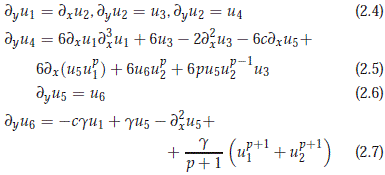
In terms of the new variable Ut = (u1, u2, u3, u4, u5, u6), we see that this system can be rewritten as an evolution in which y is considered as the time variable
∂yU= AU + G(U), (2.8)
where we have that
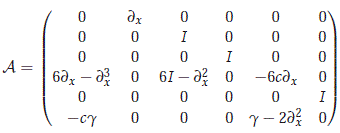
and also
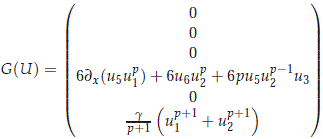
Now, for a given integer r ≥ 0, let  denote the Sobolev space of 2p-periodic functions on R whose weak derivatives up to order k are square-integrable. Then
denote the Sobolev space of 2p-periodic functions on R whose weak derivatives up to order k are square-integrable. Then  is a Hilbert space with norm given by
is a Hilbert space with norm given by

We will study the existence of x-periodic solutions for (2.8) in the Hilbert spaces H and X defined by

Note that X is densely embedded in H. If we assume that  , then we see that
, then we see that

where the matrix ∈  has the form
has the form

It is straightforward to see that the characteristic polynomial P(n, b) of  is given by
is given by

where g > 0, |c| > 0 and n ∈ Z. We note that the eigenvalues for  are roots of the cubic polynomial pn in the variable l = b2 given by
are roots of the cubic polynomial pn in the variable l = b2 given by

where a0(n), a1(n) and a2(n) are defined as
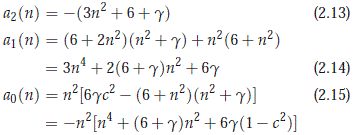
Eigenvalues of 
We want to compute the eigenvalues of  . For n = 0, we have that a0(0) = 0, a1(0) = 6g > 0, a2(0) = – (6 + g) < 0 and the cubic equation (2.12) can be easily solve since
. For n = 0, we have that a0(0) = 0, a1(0) = 6g > 0, a2(0) = – (6 + g) < 0 and the cubic equation (2.12) can be easily solve since

In other words, we have the existence of six eigenvalues for  given by,
given by,

Assume now that n ≠ 0. We will see that for g > 0 and c2 > 1 large enough, the polynomial pn has a real root l1(n) which is negative for a finite number of n's and positive for infinitely many n's. To do this we need somehow to localize the roots of the polynomial p'n for n ≠ 0. Note that

has real roots given by
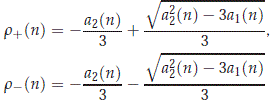
since

Moreover, a direct computation shows that
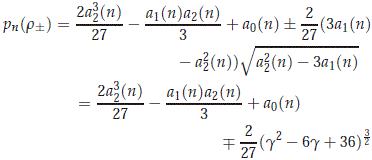
From this, we conclude for any n ≠ 0 that

On the other hand, we have that
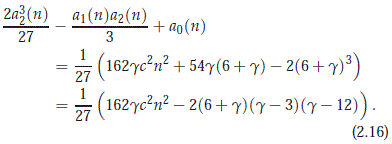
Using this we have that

We set f (g) = (g2 - 6g + 36)3 - ((6+ g)(g - 3)(g -12))2. We see that f (0) = f (6) = 0 and that f '(0) = f '(6) = 0, so we have that

which implies that

and so, we have for g > 0 that

Now we note that

so, we have that pn(r+) is positive for |n| large and could be negative for a finite number of n's. As a consequence of this, for n ≠ 0 the polynomial pn has a real root l1(n), whose sign depends on the sign of a0(n). In the case pn(r+) > 0, there are two conjugate complex roots l2(n) and l3(n) = l2(n), and in the case pn(r+) < 0 there are two positive real root l2(n) ≥ l3(n) > 0. Finally, we want to determine the sign of l1(n) for g > 0. We first observe for c2 > 1 large enough and g > 0 that there is n0 ≠ 0 such that

From this fact, we conclude for c2 > 1 large enough and g > 0 that

Right and left eigenvectors of 
As we established above, b1(0) = b2(0) = 0 is an eigenvalue. We see directly that the eigenvectors are

and left eigenvectors

The eigenvalue b3(0) = √g = -b4(0) are single eigenvalues with right eigenvectors

and left eigenvectors

On the other hand, the eigenvalue b5(0) = √6 = -b6(0) are single eigenvalues with right eigenvectors

and left eigenvectors

Now, we will describe the form of the eigenvalues for  for n ≠ 0. In this case, we have that
for n ≠ 0. In this case, we have that

and for g > 0 we have that

A direct computation shows for 1 ≤ m ≤ 6 that bm(n) is a single eigenvalue with right eigenvector

where Qm(n) = b2m(n) - (g + n2). It is also straightforward to show that left eigenvector zm(n) is given by

where qm(n) = b2m(n)(b2m(n) - (6 + n2)) and Q(m, n) is taken such that

If we introduce the matrices Z(n) and V(n) given by
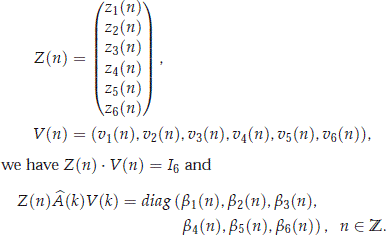
Now, we observe that given any vector  ∈ R6, we may write
∈ R6, we may write

Where
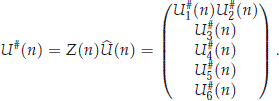
Using this representation, we have for  that
that

We define the projections p0 and p1 for g > 0 by
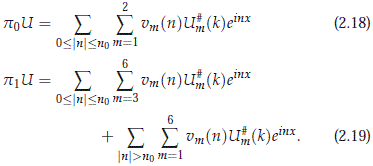
We see directly from the explicit form of the roots of the polynomial pn that |bm(n)| grows asymptotically linearly in |n|. In fact, we must recall that the roots lm(n) of ∈  for 1 ≤ m ≤ 3 depend on the discriminant D(n) of pn defined as
for 1 ≤ m ≤ 3 depend on the discriminant D(n) of pn defined as

where Q and R are defined by

More concretely, we have the following known result that characterizes the roots for a cubic polynomial
1. if D(n) is positive, then pn has one real root (l1(n)) and two are complex conjugates (l2(n) and l3(n) = l2(n)).
2. if D(n) is negative, then pn has three different real roots, and
3. if D(n) = 0, then pn has three real roots, with two of them are equal (l2(n) = l3(n)).
Moreover, the roots of the polynomial pn defined in (2.12) are explicitly given by
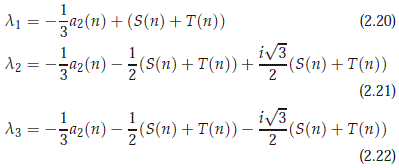
where S(n) and R(n) are numbers defined as

such that S(n) + T(n) ∈ R and that S(n) - T(n) ∈ R for D(n) ≥ 0, and S(n) + T(n) ∈ R and that S(n) - T(n) iR for D(n) < 0. In this particular case, we have for n ≠ 0 that

Using this we see that Q(n) = O(1) and R(n) = O(n2) for |n| large enough, meaning that D(n) = O(n4) for |n| large enough, and that |S(n)| = |T(n)| = O(n2) for |n| large enough. Using previous facts and formulas (2.20)- (2.22) for |n| large enough, we conclude for 1 ≤ m ≤ 3 and |n| large enough

and so, for |n| large enough and 1 ≤ m ≤ 6, we have that

Using this fact it is not difficult to verify that in terms of the coefficient vectors U#(n) we have the following equivalence of norms:

From the equivalences in (2.25) it is evident that p0 and p1 are bounded on H and on X with p0 + p1 = I, and it is clear that AXj ⊂ Hj where Xj = pjX and Hj = pjH for j = 0, 1. This yields the spectral decompositions H = H0 ⊕ H1 and X = X0 ⊕ X1.
2.1. Center manifolds of finite dimension and infinite codimension
Here we consider an abstract differential equations of the form

where X and Hare Banach spaces with X densely embedded in H, A ∈ L (X, H), the space of bounded linear operators from X to H, and f is continuously differentiable from H into H with f(0) = 0 and Df(0) = 0. We will assume that the nonlinear part f has the regularizing effect: f (H) ⊂ X. This hypothesis on f is a stronger condition than those imposed in many works related with the existence center manifolds, but this completely natural for the Boussinesq type system considered in this paper. Existence of a local finite dimensional center manifold can be established in the same fashion as the approach used in Quintero & Pego(2002) in the case of having a center space with infinite dimension and infinite codimension for the Benney-Luke model. As in the later model, we must observe that the cutoff will be performed in the H norm, and not in the X norm as in Quintero & Pego(2002). This is important since we need to use an energy functional which is defined on H, which is conserved in time for classical solutions (taking values in X), but is indefinite in general. Fortunately for us, this energy controls the H norm for solutions on the center manifold. So, we require obtaining a center manifold that contains solutions with large X norm but small H norm. This is a consequence that the nonlinearity f has a smoothing property, mapping H into X.
We will state the result for the existence of a locally invariant center manifold of classical solutions for the system (2.26) under certain conditions which allow the center subspace (that associated with the purely imaginary spectrum of A) to have finite dimension and infinite codimension. We start with some basic definitions and some hypotheses:
Definition 2.1. Let J ⊂ R be an open interval and u: R → H be a function. We say that u is a classical solution of (2.26) on J if the mapping y → u(y) is continuous from J into X, is differentiable from J into H and (2.26) holds for all y ∈ J.
Let b > 0, let Y and Z be Banach spaces and U be an open set in Y. We define the Banach spaces Cb(U, Z), Lip(U, Z) and Yb by
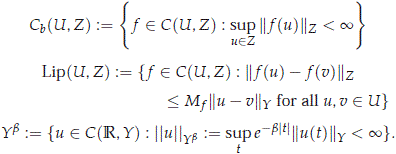
Throughout this section we assume that there are bounded projections p0 and p1 on H such that
(i) (i) H = H0 ⊕ H1 with Hi : = pi(H),
(ii) pi|X is bounded from X to X, and
(iii) AXi ⊆ Hi where Xi := pi(X), for i= 0, 1.
We see that equation (2.26) can be rewritten as the first order system

where Ai ∈ L (Xi, Hi) with Aiy = piAy for y ∈ Xi.
We assume the following splitting properties for the operator A1, associated with the linear evolution equation du/dy = Au.
(H1) There exists a > 0 and a positive function M1 on [0, a) such that for any b ∈ [0, a) and for any g1 ∈ C (R, X1) ∩ Hb1 the equation

has a unique solution in Hb1 given by u1 = K1g1, where K1∈ L(Hb1 ) with ||K1|| L(Hb1) ≤ M1(b). Furthermore ||K1|| L(Xb1) ≤ M1(b).
As done by J. Quintero and R. Pegoin the case of the Benney-Luke model (see Quintero & Pego(2002)), we easily have that
Theorem 2.1 (Local Center Manifold Theorem). Let H, X, A, p0, p1 and f be as above, and let

Then for all sufficiently small d > 0 there exists jd : H0 → X1 such that
(i) jd(0) = 0 and Djd(0) = 0.
(ii) jd ∈ Cb(H0, X1) ∩ Lip(H0, X1), and on any ball B(d '), jd has Lipschitz constant L(d ') satisfying L(d ') < ½ and L(d ') → 0 as d ' → 0+.
(iii) The manifoldMd ⊂ X given by

is a local integral manifold for (2.26) over B(d) ∩ X0. That is, given any y ∈ Md there is a continuous map u: R → Md with u(0) = y, such that for any open interval J containing 0 with p0u(J) ⊂ B(d) it follows that u is a classical solution of (2.26) on J. Moreover, u0 := p0u is the unique classical solution on J with u0(0) = p0y to the reduced equation

where Fd : H0 → X0 is locally Lipschitz and is given by Fd(w):= p0 f (
(iv) For any open interval J ⊂ R, every classical solution u0 ∈ C1(J, H0) ∩ C(J, X0) of the reduced equation (2.30) such that u0(y) ∈ B(d) for all y ∈ J yields, via u= u0 + jd(u0), a classical solution u of the full equation (2.26) on J.
(v) The manifold Md contains all classical solutions on R that satisfy ||u(y)||H ≤ d for all y.
2.2. Linear dynamics analysis.
Now we are interested in establishing the solvability conditions to the linear level. First we consider the center subspace H0. We define the bounded C0-group {S0(y)}y∈R on H0 with infinitesimal generator A0 = A |X0 by

Now, we want to determine the Green function to solve the problem in the hyperbolic subspace H1. Let us consider the inhomogeneous linear equation

where A1 = A|X1 . We need to observe that |ℜ(lm(n)| ≥ a > 0 for all n ∈ Z, except for m = 1, 2 when n ≠ 0. Let 0 ≤  < a and let G ∈ C(R, X1) ∩ H
< a and let G ∈ C(R, X1) ∩ H 1, where for any Banach space Y,
1, where for any Banach space Y,

Hereafter we will assume m and n are such that 1 ≤ m ≤ 6 and n ∈ Z \ {0}, or m = 5, 6 for n= 0. Suppose U ∈ C1(R, H1) ∩ C(R, X1) is a solution belonging to H 1. Then using the Fourier series expansion in x and multiplying by the matrix Z(n) yields the differential equation
1. Then using the Fourier series expansion in x and multiplying by the matrix Z(n) yields the differential equation

The functions G#m(n, ·) and U#m(n, ·) belong to R (Y = R in (2.33)). From the fact that |bm(n)| ≥ a >
(Y = R in (2.33)). From the fact that |bm(n)| ≥ a >  , we conclude necessarily that
, we conclude necessarily that

where for 0 <| n |≤ n0 we have u = 3, 5 and s= 4, 6, and for | n |> n0 we have u= 1, 3, 5 and s= 2, 4, 6. As a direct consequence any solution of (2.32) in H 1 is unique. We will see that the formulas (2.35) together with the representation for U= p1U in (2.19) allow us to establish the existence of a solution in H
1 is unique. We will see that the formulas (2.35) together with the representation for U= p1U in (2.19) allow us to establish the existence of a solution in H 1. To see this, we decompose equation (2.32) using projections into the "unstable" and "stable" subspaces. The projections for U ∈ H are
1. To see this, we decompose equation (2.32) using projections into the "unstable" and "stable" subspaces. The projections for U ∈ H are
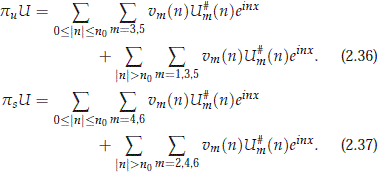
Clearly pu and ps are bounded on H and X and pu + ps= p1. Now, we introduce a Green's function operator S(y) defined for nonzero y ∈ R by
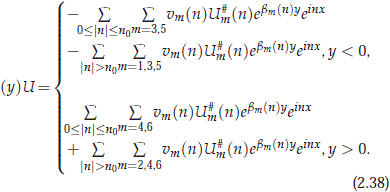
By the definition of the norm in H and X (see (2.25)), we have that
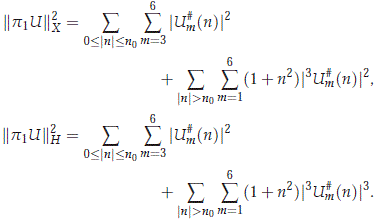
On the other hand, for 1 ≤ m ≤ 6 and y ≠ 0 and n ≠ 0, we have that

Using this fact, we see directly for Y = H or X that,
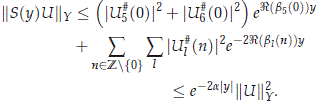
We also have for y > 0 that
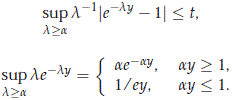
Following the same type of calculation and using previous facts, one can easily verify that for some constant C (independent of y) we have the following norm bounds:


where L(Y) and L(H, X) respectively denote the space of bounded operators on Y, and from H to X. Clearly, we have that S(y) → ps(resp. -pu) strongly as y → 0+ (resp. 0-). Therefore the families {S(y)}y>0 and {-S(-y)}y>0 are analytic semigroups in psH and puH respectively (?, p.62). Moreover, we also have that S is C1 from R \ {0} to L(H) with dS(y)/dy = A1S(y). Therefore, we conclude that equation (2.35) yield the formula

for the solution of (2.32). Finally, we need to establish that U ∈ C(R, X), U ∈ H 1, and dU/dy exists in H and satisfies (2.32). The computations in this case follows as those done for the Benney-Luke equation in ?, but for completeness we include the details. First observe that
1, and dU/dy exists in H and satisfies (2.32). The computations in this case follows as those done for the Benney-Luke equation in ?, but for completeness we include the details. First observe that

The first term is in C(R, X) since G ∈ C(R, X) and we have the estimate (2.39). Now, since G ∈ H , the we may use (2.40) to see that the second integral converges in X uniformly on compact sets in y. Then we have that U ∈ C(R, X).
, the we may use (2.40) to see that the second integral converges in X uniformly on compact sets in y. Then we have that U ∈ C(R, X).
On the other hand, using (2.39) we have for Y = H or X that U ∈ Y . In fact, if G ∈ Y
. In fact, if G ∈ Y then
then

Moreover, we have that

It remains to show U = psU +puU is differentiable in H and satisfies (2.32). We check in a standard fashion that psU is differentiable. For h > 0 we compute
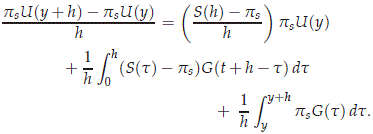
Using (2.41) and G ∈ C(R, X), as h → 0+ we deduce that

Since we have that S(y) → ps strongly as y → 0+, the we have that

Hence the right derivative exists and satisfies D+psU(t) = A1psU(t) + psG(t), so is continuous into H. It follows that psU is differentiable. We may treat puU in a similar way, and conclude that U is differentiable and satisfies (2.32). So, from the Theorem 2.1, we have established that system (2.8) admits a local center manifold having the properties stated in the Theorem.
2.3. Global existence and stability for g > 0 and |c| > 1 (large enough)
We are now interested in proving global existence of classical solutions on the local center manifold, for initial data that is small in H-norm, which follows from the fact that the zero solution is stable on the center manifold characterized by the graph of a function jd : H0 → X1. We use strongly the existence an energy functional that is conserved in time for classical solutions. We define the energy functional e : H → R by e(U) = e0(U)+e1(U), where the quadratic part is
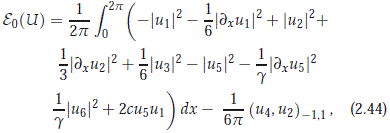
where (·, ·)-1,1 represents the pairing between  -1 and
-1 and  1, and the remaining part is
1, and the remaining part is

From the definition, e is a smooth function from H to R. After multiplying appropriately the equation (2.6) by u2 and equation (2.7) by u6, one can easily verify that if U ∈ C1(R, H) is a classical solution of the first order equation (2.8), then for all y ∈ R

Even though previous property, this energy can not be used to obtain a solution throughout the variational method since neither e nor e0 is not positive define in the space H. We will see that energy e0 is positive on the center space H0, and also that this controls the norm of U in H, via the center manifold result. We note that from the definition of the variable U = (u1, u2, u3, u4, u5, u6), we have a priori that u1 = ∂xv has mean zero on [0, 2p], meaning that  1(0) = 0.
1(0) = 0.
Lemma 2.1. Let |c| > 1 large enough and g > 0. Then there is a positive constant M0 > 1 such that for any U ∈ H0 with  1(0) = 0,
1(0) = 0,

Proof. From the Fourier series representation of U ∈ H0 given with  1(0) = 0, we have that
1(0) = 0, we have that
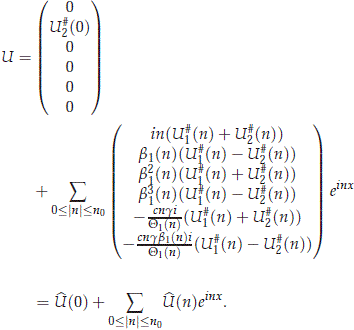
We also have that  We note that
We note that

On the other hand, for b1(n) = b we have that

where

Since for |c| > 1 (large enough) we have that b21(n) = l1(n) < 0 for 0 < n ≤ n0, then we have the right side of the second term is positive. Now, for the first term, we use the polynomial equation for b1(n) given in (2.11). First note that

where L1 and L2 are given by

But we have that

Using this, we get that

But from (2.11), we have that

Then using that b21(n) < 0 for 0 < n ≤ n0, we finally get that

This fact implies that
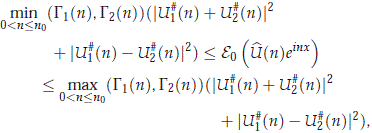
which implies that

In other words, we have shown that

The first consequence of this fact is the following result:
Corollary 2.1. Let |c| > 1 large enough and g > 0. Then there are d1 > 0 and M1 > 1 such that for any U ∈ H0 with  1(0) = 0 and ||U||H < d1,
1(0) = 0 and ||U||H < d1,

Proof. First note that from the Hölder inequality with q = p + 2, there is some positive constant C = C(p) (independent of U) such that

Moreover for some constants C0 and C1 = C1(p) (independent of U), we conclude that

Let d1 > 0 be such that C0 - d p1C1 > 0. Then for ||U||H ≤ d1 with U ∈ H0 \ {0} we have that

The second claim of this lemma follows directly. In fact, for U ∈ H we have that

Now, we are interested in estimating the energy e on the center manifold. In other words, we want to obtain a similar estimates for the lift of e to the center manifold Md.
Lemma 2.2. sl Let jd as in Theorem 2.1. Then there exist constants d2 > 0 and C2 > 1 such that for all x ∈ H0 with ||x||H < d2 we have

Proof. Let us define the functional  : H0 → R by
: H0 → R by

where the function jd is defined in Theorem (2.1). First note that ||jd(x)||H = 0(||x||H). Since e is smooth and e(0) = 0, then e'(x) = O(||x||H). As a consequence of this fact and that e1(U) =  , we have for x ∈ H0 that
, we have for x ∈ H0 that

as ||x||H → 0. Then by the previous result, we get the conclusion.

We first establish that solutions starting in the center manifold are appropriately bounded.
Lemma 2.3. Let x ∈ X0 be such that  1(0) = 0 and that ||x||X ≤ d2. There exists a unique classical solution U(x, ·) for the full problem (without cutoff) (2.8) on R with initial condition p0 ° U(x, 0) = x such that on any open interval J containing 0,
1(0) = 0 and that ||x||X ≤ d2. There exists a unique classical solution U(x, ·) for the full problem (without cutoff) (2.8) on R with initial condition p0 ° U(x, 0) = x such that on any open interval J containing 0,

Proof. We may assume that d2 small enough such that d2 << d. Let x ∈ X0 be such that ||x||X ≤ d2. Now, from Theorem 2.1, there exists a unique continuous function U form R to the local center manifold Md such that p0(U(0)) = x, which turns out to be a classical solution of the equation (2.8) on any open interval J ⊂ R containing 0 such that ||p0(U(y))||H ≤ d for any y ∈ J. On the other hand, since U is a classical solution and the energy E is conserved, then we have for any y ∈ J that

meaning ||p0(U(y))||H ≤ C2||x||H, for any y ∈ J as desired. A continuation argument shows that U is a classical solution for the full problem (without cutoff) (2.8) on R.

Now we are in position to state the main result on the existence and the stability on the center manifold. The proof of this result follows in the same fashion as the Benney-Luke equation done by Quintero and Pego in ?.
Theorem 2.2. (Global Existence and stability on the center manifold) Let jd be given by applying Theorem 2.1 to (2.8). There exist positive constants d3 and C3 such that, for any x ∈ X0 with  1(0) = 0 and ||x||H ≤ d3, there is a unique classical solution U on R to (2.8) such that p0U(0) = x and ||U(y)||H ≤ 2C2||x||H for all y ∈ R. Moreover, for any T > 0 the map taking x to U is Lipschitz continuous from H0 to C([–T, T], H).
1(0) = 0 and ||x||H ≤ d3, there is a unique classical solution U on R to (2.8) such that p0U(0) = x and ||U(y)||H ≤ 2C2||x||H for all y ∈ R. Moreover, for any T > 0 the map taking x to U is Lipschitz continuous from H0 to C([–T, T], H).
Acknowledgments. J. R. Quintero was supported by the Mathematics Department at Universidad del Valle (Colombia) under the project C.I. 7910.
References
Grover, M. (2001). An existence theory for three-dimensional periodic travelling gravity-capillary water waves with bounded transverse profiles. Physica D 152(1): 295-415. [ Links ]
Grover, M., Mielke, A. (2001). A spatial dynamics approach to three-dimensional gravity-capillary steady water waves. Proc. Royal Soc. Edin. A131(1): 83-136. [ Links ]
Grover, M., Schneider, A. (2001). Modulating pulse solutions for a class of nonlinear wave equations. Commun. Math. Phys. 219: 489-522. [ Links ]
Haragus-Courcelle M., Schneider G. (1999). Bifurcating fronts for the Taylor-Couette problem in infinite cylinders. Z. Angew. Math. Phys. 50: 120-151. [ Links ]
Kirchgässner, A. (1982). Wave solutions of reversible systems and applications. J. Diff. Eqns. 45: 113-127. [ Links ]
Mielke, A. (1988). Reduction of quasilinear elliptic equations in cylindrical domains with applications. Math. Meth. Appli. Sci. 101: 51-56. [ Links ]
Mielke, A. (1991). Hamiltonian and Lagrangian Flows on Center Manifolds. Berlin: Springer-Verlag. [ Links ]
Mielke, A. (1992). On nonlinear problems of mixed type: a qualitative theory using infinite-dimensional center manifolds. J. Dyn. Diff. Eqns. 4 (1): 419-443. [ Links ]
Pazy, A. (1983). Semigroups of Linear Operators and Applications to Partial Differential Equations. Springer-Verlag, New York. [ Links ]
Quintero J., Pego R. (1999). Two-dimensional solitary waves for a Benney-Luke equation. Physica D 132: 476-496. [ Links ]
Quintero J., Pego R. (2002). A host of Travelling Waves in a Model of Three-Dimensional Water-Wave Dynamics. Nonlinear Science 12: 59-83. [ Links ]
Sandstede B., Scheel A. (1999). An Essential instability of pulses and bifurcations to modulated travelling waves. Proc. Roy. Soc. Edin. A 129: 1263-1290. [ Links ]
Sandstede B., Scheel A. (2004). Defects in oscillatory media: Toward a classification. SIAM J. Appl. Dynam. Syst. 3: 1-68. [ Links ]
Scarpellini, B. (1990). On nonlinear problems of mixed type: a qualitative theory using infinite-dimensional center manifold.I and II. J. Appl. Math. Phys. (ZAMP). 42: 289-314. [ Links ]
Vanderbauwhede, A., and Iooss, G. (1982). On nonlinear problems of mixed type: a qualitative theory using infinitedimensional center manifold. I and II. Dynamics Reported,New Series 1: 125-163. [ Links ]
Vanderbauwhede A. (1989). Centre manifolds, normal forms and elementary bifurcations. Dynamics Reported, New Series 2: 89-169. [ Links ]













